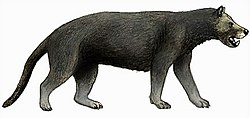Ysengrinia
Appearance
| Ysengrinia Temporal range:
| |
|---|---|

| |
| Restoration | |
| Scientific classification | |
| Kingdom: | |
| Phylum: | |
| Class: | |
| Order: | |
| Suborder: | |
| Family: | |
| Subfamily: | |
| Genus: | †Ysengrinia Leidy (1853)
|
| Species | |
| |
Ysengrinia is an extinct genus of large, mostly carnivorous bone-crushing mammals known as bear dogs, of the family Amphicyonidae found in Europe and North America during the Early Miocene, and possibly in southwestern Africa during the Early Miocene.[1][2]
Taxonomy
Ysengrinia was named by Leidy (1853). was named by Ginsburg (1965). It was assigned to Amphicyoninae by Hunt (1998); and to Amphicyonidae by Ginsburg (1965), Carroll (1988) and Hunt (2002).[3]
Morphology
A single specimen was examined by Legendre and Roth for body mass and was estimated to weigh 71.6 kg (160 lb).[4]
References
- ^ McKenna, M.C.; Bell, S.K. (1997). Classification of Mammals: Above the Species Level. New York: Columbia University Press. p. 631. ISBN 978-0-231-11013-6.
{{cite book}}: Invalid|ref=harv(help) - ^ Hunt, R.M. (2002). "Intercontinental migration of Neogene Amphicyonids (Mammalia, Carnivora): Appearance of the Eurasian beardog Ysengrinia in North America". American Museum Novitates. 3384 (1): 1–53. doi:10.1206/0003-0082(2002)384<0001:imonam>2.0.co;2. hdl:2246/2873.
{{cite journal}}: Invalid|ref=harv(help) - ^ Hunt, R. M. (2002). "New amphicyonid carnivorans (Mammalia, Daphoeninae) from the early Miocene of southeastern Wyoming". American Museum Novitates. 3385: 1–41. doi:10.1206/0003-0082(2002)385<0001:nacmdf>2.0.co;2.
- ^ Legendre, S.; Roth, C. (1988). "Correlation of carnassial tooth size and body weight in recent carnivores (Mammalia)". Historical Biology. 1 (1): 85–98. doi:10.1080/08912968809386468.
